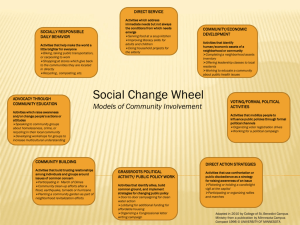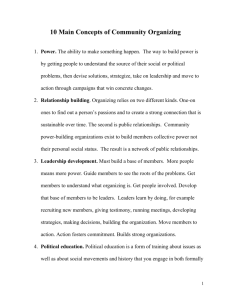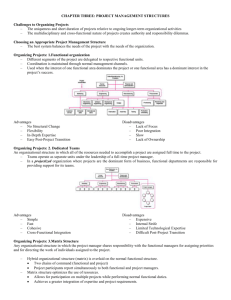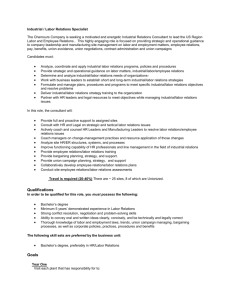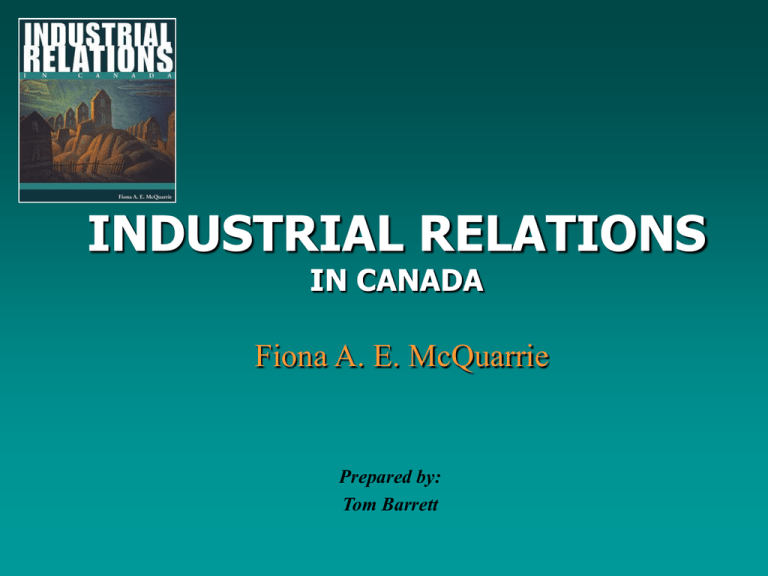
INDUSTRIAL RELATIONS
IN CANADA
Fiona A. E. McQuarrie
Prepared by:
Tom Barrett
Chapter
5
The Organizing Campaign
Opening Vignette:
McDonald’s union drive campaign
• Labour experts say tougher legislation for union
certification in Ontario and Alberta will make
organizing McDonald’s outlets more difficult than in
other jurisdictions
• But organizing will likely be difficult, even in relatively
union-friendly B.C. and Quebec; McDonald’s workers
tend to be young, part-time, transient and in small
operations, which hampers organizing
• Charlotte Yates, a professor of labour studies at
McMaster University, said the campaign signals a new
wave of organization; unions today recognize they
need to tackle the service sector, where most new
jobs are being created
Chapter 5 Objectives
• At the end of this chapter, you should be able to:
– Explain why a collective bargaining relationship
would be considered
– Describe the steps in an organizing campaign
– Understand what is required to apply for
certification
– Identify what factors must be addressed in a
certification application
– Identify two special situations involving organizing
campaigns and certification applications
The Organizing Campaign
• Canadian labour legislation in all jurisdictions
recognizes the right of most kinds of employees
to freely choose to be a member of a trade union
and to participate in the union’s lawful activities
• Many employees are first introduced to the idea
of joining a union through an organizing
campaign
• An organizing campaign is conducted by a union
in a workplace to persuade employees to choose
the union as their legal representative
The Organizing Campaign
(cont’d)
• Factors Affecting Employee Support for a
Union
– What are the factors that ultimately determine
whether employees will vote for or against
having a union?
– Researchers have identified many factors,
although this research has not always
distinguished between the different decisionmaking points that employees pass through in
the organizing process
Factors Affecting Employee
Support for a Union
• Different factors may be more or less
important at different decision points.
Research studies roughly fall into four
categories: personal factors, workplace
factors, economic factors, and societal factors
• Personal Factors
– Parental attitudes or union activity
• If parents were active in unions or held positive
attitudes toward unions, workers may be more
likely to support a union
Factors Affecting Employee
Support for a Union
(cont’d)
• Socio-economic status
– Low socio-economic status, low income, and
minority group membership may make
workers more likely to support a union
• Instrumentality
– If a specific union is perceived as being able to
achieve changes that the worker cannot
achieve, the worker is more likely to support
the union
Factors Affecting Employee
Support for a Union
• Most studies acknowledge that dissatisfaction
with workplace conditions is the most
common reason employees consider joining a
union
– See Table 5-2 on next slide
Factors Affecting Employee
Support for a Union
Factors Affecting Employee
Support for a Union
• Factors beyond the organization and the
individual that affect unionization decisions
Factors Affecting Employee
Support for a Union
• General societal attitudes about unions
influence individuals’ inclinations to support a
union in their workplace
Steps in the Organizing
Campaign
• A successful campaign results in the union being
able to request recognition as the bargaining
agent for the employees
• An organizing campaign can be initiated by either
a union or by the employees
• Most employees who initiate an organizing
campaign decide to contact an established union
• Organizing campaigns in the Canadian private
sector all follow the pattern outlined on the next
slide
Steps in the Organizing
Campaign
Steps in the Organizing
Campaign
• The Information Meeting
– The first formal step in an organizing campaign is
to meet after working hours and off company
property
– Interested employees and a union representative
discuss issues that generate interest in a union;
also assess likelihood of a successful campaign
– Identities of employees interested in unionization
are kept secret from employer and from proemployer workers
– The fact that an information meeting is being held
may also be kept secret
The Organizing Committee
• If the information meeting suggests an organizing
campaign could be successful, an organizing
committee will be created
• The committee usually consists of several employees
and an experienced union organizer
• Committee members will contact other employees
before or after work, on breaks, or at their homes,
seeking a formal indication of support for the union
• A constant concern throughout the campaign is the
possibility of unfair labour practices as outlined in
labour law; such practices may affect the vote which
in turn, may not reflect the employees’ true wishes
Steps in the Organizing
Campaign
• The Application for Certification
• When the organizing committee believes it has
sufficient membership support, the union files an
Application for Certification with the appropriate
labour relations board
• This form has three major components:
– An indication of sufficient membership support
– A description of the desired bargaining unit (the group
of employees that will be represented in collective
bargaining with the employer)
– An indication of the employer and the trade union
covered
Steps in the Organizing
Campaign
• The Application for Certification:
Sufficient Membership Support
– The question of what constitutes sufficient
support is one of the most contentious issues
that labour relations boards and legislators
have to deal with
– The required level of support varies from
jurisdiction to jurisdiction
• See Table 5-5 on the following slide
Steps in the Organizing
Campaign
Steps in the Organizing
Campaign
The Application for Certification:
Sufficient Membership Support
– A labour relations board may consider
applications with less than the required level
of support if the union can show that the
employer committed an unfair labour practice
Steps in the Organizing
Campaign
The Application for Certification:
Sufficient Membership Support
– The board will attempt to assess the effect of
the employer’s behaviour; the board then
may:
• Allow the application to proceed
• Permit the union to attempt to collect further
indications of support
• Deny the application
• Declare the union’s certification immediately
Steps in the Organizing
Campaign
The Application for Certification:
Sufficient Membership Support
– In some jurisdictions, if the level of support
exceeds a specified amount, the union may
receive automatic certification
– If the level of support for certification exceeds
the stated minimum but does not reach the
level needed for automatic certification (in
jurisdictions where this applies) the board will
require an employee vote
Steps in the Organizing
Campaign
The Application for Certification:
Sufficient Membership Support
– The level of support required for certification
applications to be made tends to fluctuate
with the philosophy of the party in power
– This threshold is extremely important in
determining whether organizing campaigns
succeed or fail
– The timeliness of the application may also
affect a board’s assessment
Steps in the Organizing
Campaign
The Application for Certification:
Appropriate Bargaining Unit
– Every certification application must contain a
description of the bargaining unit the union
seeks to represent; this generally consists of
descriptions of the jobs that will or will not be
represented by the union
Steps in the Organizing
Campaign
The Application for Certification:
Appropriate Bargaining Unit
– Two purposes for this bargaining unit
description:
• Labour relations board can match employee
signatures with job descriptions
• The board can assess whether the proposed
unit is appropriate
Steps in the Organizing
Campaign
The Application for Certification:
Appropriate Bargaining Unit
– Considerations a board will address in determining
whether a bargaining unit is appropriate:
• Size and location of the bargaining unit
• Managerial and non-managerial employees
• Definition of an employee
– The principle underlying all of these considerations
is community of interest – there should be enough
relevant characteristics in common among the
applicants to make the union a cohesive and
representative unit
Steps in the Organizing
Campaign
The Application for Certification:
Appropriate Bargaining Unit
– Size and location – The union wishes to
represent as many employees as possible
because of union dues and because of
increased power
– However, there are practical difficulties
associated with administering a bargaining
unit that is too large or too dispersed
– A labour relations board tries to ensure a
relative balance of bargaining power between
the employer and the union
Steps in the Organizing
Campaign
The Application for Certification: Appropriate
Bargaining Unit
– Managerial and Non-Managerial Employees – Who is
eligible to be in the bargaining unit?
– A general policy in legislation is that bargaining units
should not include both managerial and nonmanagerial employees
– However, it is sometimes very difficult to determine
who is a manager
– Employees who perform work involving administrative
support to top managers are usually excluded from the
bargaining unit. These are known as exempt
employees
Steps in the Organizing
Campaign
The Application for Certification:
Appropriate Bargaining Unit
– Defining an “Employee”
• An “employee” is generally defined in
legislation as someone who works on a regular
basis for an employer in a dependent
relationship
• An employee is also someone who performs his
or her work under the direction and control of
the employer
Steps in the Organizing
Campaign
– Defining an employee (cont’d)
• The size of the bargaining unit may be eroded
if employers replace full-time permanent
workers with temporary or part-time ones
• An employer might also eliminate positions
entirely and have the work performed by
workers employed by another, non-union,
company – known as outsourcing
• Labour relations boards generally hold that if a
worker has an ongoing dependent relationship
with an organization, the worker should be
considered an employee and included in the
bargaining unit
Steps in the Organizing
Campaign
– Defining an employee (cont’d)
• Labour relations boards and legislators are
strict about enforcing the definition of
“employee” in order to prevent employers from
escaping their responsibilities under the
collective agreement by reducing the
bargaining unit
• A board will not reject an application for
certification simply because the application
contains a bargaining unit description that the
board considers inappropriate; the board will
usually contact the union and suggest
alterations
Steps in the Organizing
Campaign
– Defining an “Employer”
• The applicant is required to indicate which
employer the application covers; not every
labour code defines “employer,” and this has
caused problems
• Criteria a labour relations board will consider
when determining who is the employer:
– Where does the authority for hiring lie?
– What part of the business is accountable for
establishing and monitoring work conditions?
– Who exercises control over day-to-day work and
production?
Steps in the Organizing
Campaign
– Defining an “Employer” (cont’d)
• When an owner or corporation conducts
business through multiple corporate entities
that share resources, a labour relations board
may declare all of the entities to be a single
employer or common employer
Steps in the Organizing
Campaign
• The Application for Certification:
Defining a “Trade Union”
– The final component in a certification
application is an indication that it comes from
a bona fide trade union
– Under most labour codes, a bona fide union:
• Was established free of employer interference
• Is run on democratic principles
Steps in the Organizing
Campaign
• Most Canadian labour legislation does not
recognize an employees’ association that is
dominated or influenced by an employer –
known as a company union; the result of
such arrangements is known as a sweetheart
agreement
Steps in the Organizing
Campaign
The Construction Industry
• Canadian labour legislation recognizes
that conditions for organizing in the
construction industry differ from
other industries
• Each project or work site is considered
to be a workplace and a separate
certification must be obtained for each
project and for each unionized trade
working on the project
Steps in the Organizing
Campaign
• A construction employer who wins a contract
stipulating that unionized workers will be
employed, will contact the appropriate union
and request that the union provide the
appropriate unionized employees
Steps in the Organizing
Campaign
• Voluntary Recognition
– Most Canadian labour law permits an
employer to recognize the union’s right to act
as the exclusive bargaining agent without
official recognition from a labour relations
board
– This acceptance is known as voluntary
recognition
Steps in the Organizing
Campaign
• The employer accepts the union as the
employees’ bargaining agent without any
representation vote or other formalization of the
union’s existence
• Labour law in several provinces allows a board to
grant certification if a voluntary recognition
agreement has been in effect for several years
– See Table 5-6 on the next slide for Voluntary
Recognition statistics
Voluntary Recognition in Canada
Copyright
Copyright © 2002 John Wiley & Sons Canada, Ltd. All rights reserved.
Reproduction or translation of this work beyond that permitted by
CANCOPY (Canadian Reprography Collective) is unlawful. Request for
further information should be addressed to the Permissions Department,
John Wiley & Sons Canada, Ltd. The purchaser may make back-up copies for
his / her own use only and not for distribution or resale. The author and the
publisher assume no responsibility for errors, omissions, or damages, caused
by the use of these programs or from the use of the information contained
herein.

